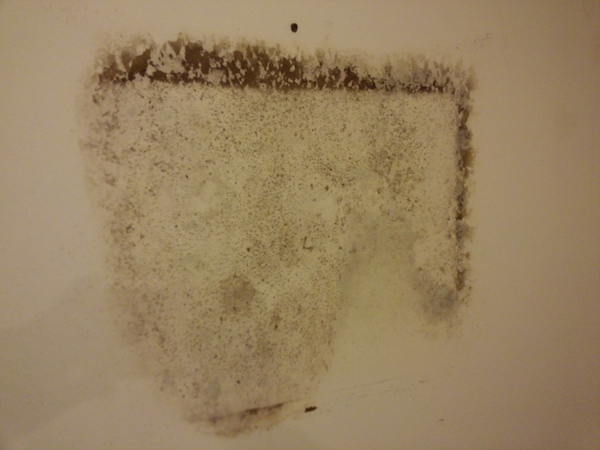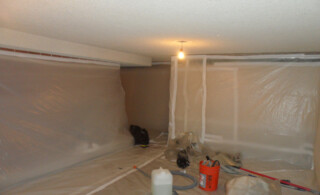
Although toxic black mold is a headline grabber, mold comes in a wide variety of colors and is often not even easy to see. It creeps up the inside of walls, collects in water-damaged basements and crawl spaces, and grows inside poorly cleaned humidifiers, dehumidifiers, and air conditioning units.
Mold and Your Health
The health concerns of mold are wide ranging and cause respiratory and many other problems. While infants, young children, the elderly, and the immune-compromised are at the greatest risk, mold can affect anyone, causing everything from a mild allergic reaction to mycotoxicosis and more serious diseases. According to the Mayo Clinic, nearly all of the 37 million chronic sinus infections are a result of mold. Mold has been linked to both causing asthma and advancing asthma. Fortunately, mold can be eradicated if you know what it is and where it is, which is why regular mold inspection is an important part of general home maintenance.
Extensive Mold Damage
Still, health problems associated with mold growth aren’t as common as many people believe, but that doesn’t mean the mold is innocuous. Left unchecked, extensive mold damage can require professional remediation that can cost thousands of dollars. Imagine a bathroom with inadequate ventilation. Mold builds slowly on the ceiling and walls, allowing residents to scrub them clean every few weeks. But with poor cleaning habits this mold takes over and begins to eat away at the drywall itself. The same thing happens with mold trapped inside your walls, until discoloration and bad odors require that you rip out your entire wall.
Mold Inspections
A mold inspection is a simple and important task that should be performed with regularity and/or when the situation demands. If you find water damage, discover that people in your home are having respiratory problems, or if you realize that you’ve never had an inspection, it’s a good idea to get one done and soon. The most basic inspections will cost approximately $300 for a mid-sized home, but more extensive inspections will naturally cost more. These larger inspections should be done on occasion to make sure nothing is left unchecked.
Mold Test Results from a Certified Mold Inspector
If mold damage is not due to the everyday wear and tear on an older home, you might need documented test results to reclaim costs from homeowners insurance, your real estate seller, landlord, plumber, or new home builder. A certified mold inspector is trained to search “every inch of your home” and can offer mold laboratory analysis of collected samples and a professional toxic mold inspection with full documentation. This inspector will test the air, the wall spaces and floors, as well as those appliances that might have caused the problem. These more extensive measures are a great idea if you live in an older home, if you suspect a problem, or if you have not tested in a few years.
Ready to start your mold inspection?
Find ProsDo-It-Yourself Mold Test Kits
A mold inspection test kit is easily available at any home supply store. These kits are useful for regular tests to see if there are mold spores in your air. While these kits are certainly not a stand-in for mold inspectors, they offer homeowners the ability to do regular testing between professional mold inspections. They can act as a warning system of sorts that convince you to bring in a professional for a more thorough investigation. That said, you should know that a single test result won’t tell you much. Without a baseline for the amount of mold spores already present in the air of your home, it can be difficult or impossible to discern whether mold has taken root. Plus, mold levels naturally fluctuate throughout the day. Only with repeated testing and monitoring will you be able to definitively identify a mold problem. On the other hand, mold testing is often unnecessary: If you see or smell mold, you probably have a mold problem that needs to be addressed.
Basic Precautions against Mold
The most obvious way to avoid problems is to keep a clean home. Allowing your appliances to degrade or get dirty is the easiest way to end up with a mold problem. Clean your air conditioning units with regularity. Standing water causes many problems, and only one of which is mold. Similarly, dehumidifiers and humidifiers should be scrubbed down at least once a month with antibiotic soap. Leaking or dripping showers, faucets and pipes should be fixed as soon as you see there is a problem, and shower curtains and floor mats should be used regularly as needed.
Mold sneaks up on you. It grows where you don’t see it and the problems don’t present until it is a huge problem. It causes health concerns that present themselves as colds, asthma, and other problems that might seem unavoidable or common, but are actually completely preventable. For this reason, for peace of mind, for your health, regular inspections are important. Even recognizing and cleaning up the smallest of problems will change the way you live in your home.
 Lead Paint Common Sense
Lead Paint Common Sense  How Do I Get Rid of the Moldy Odor in My Basement?
How Do I Get Rid of the Moldy Odor in My Basement?  Guide to Room-by-Room Repairs for Easy Accessibility for Disabled Loved Ones
Guide to Room-by-Room Repairs for Easy Accessibility for Disabled Loved Ones  Pool Safety Guide for Homeowners
Pool Safety Guide for Homeowners  Asbestos Removal: A Primer
Asbestos Removal: A Primer 

Are You Familiar With This Topic? Share Your Experience.